U.S. E-commerce Returns: Key Rules for Buyers and Sellers

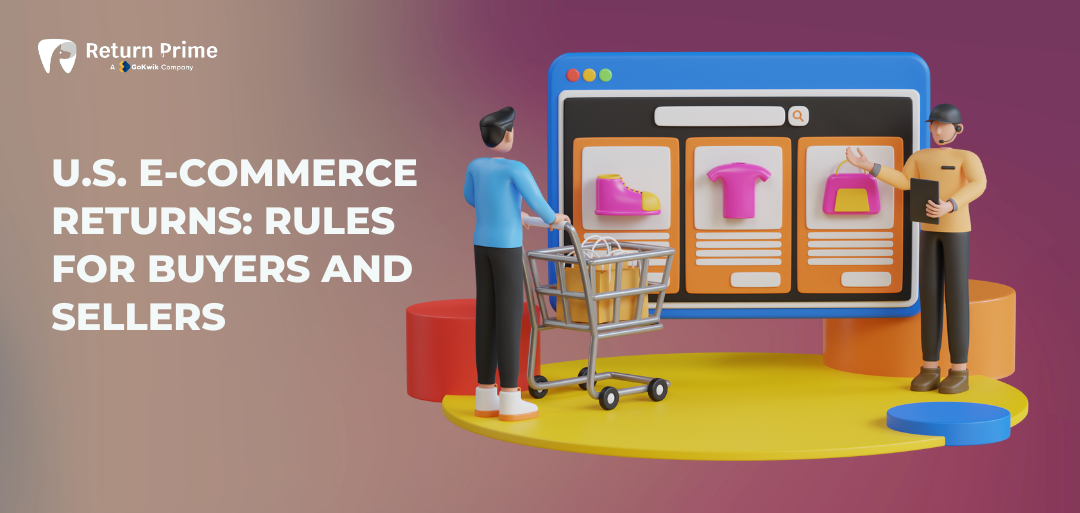
When you buy or sell through an e-commerce site, return laws can get confusing. What can customers expect if they change their mind or get a faulty product? And what should sellers know to stay compliant and avoid refund issues?
U.S. law offers clear protections for buyers and sets expectations for sellers, but many people on both sides don’t fully understand how it works.
This blog will explain the key U.S. rules regarding returns and refunds for online orders so buyers can shop with confidence and sellers can manage returns properly.
What U.S. Law Says About Online Orders
U.S. law sets some non-negotiable rules for both buyers and sellers. This section breaks down the legal basics so buyers know what to expect and sellers understand what they must do to avoid disputes, chargebacks, and compliance issues.
If You're a Seller
Selling online means you’re required to follow specific rules, even if your return policy is strict.
- You must ship on time or notify the customer
Under the FTC’s Mail Order Rule, you must ship within the promised timeframe. If none is given, you have 30 days. Can’t ship on time? You must notify the buyer, get their consent for the delay, or issue a full refund.
- Your product listings must be accurate
All descriptions, specs, and images must truthfully reflect the item. Misleading or false claims could result in legal action under deceptive trade practice laws.
- You must secure buyer data
Sellers handling credit card information must meet PCI compliance and protect customer payment data. Failure to do so can result in data breach liability.
- You may be covered under the INFORM Consumers Act
If you're a high-volume seller (200+ sales or $5,000+ in a year), marketplaces are required to verify your identity and show your business information to buyers. You can be suspended if you don’t comply.
- You're responsible for product safety
You’re liable for defective products, including design or warning defects. You must ensure products are safe and fit for their intended use.
If You're a Buyer
When you shop online in the U.S., the law gives you some basic protections, even if the seller doesn’t highlight them.
- You have the right to a timely delivery
Sellers must deliver on time or within 30 days unless stated otherwise. If there’s a delay and you don’t want to wait, they must offer a refund.
- You’re entitled to accurate product details
If you receive something different from what was advertised, you can ask for a refund, replacement, or repair. This includes wrong specifications, materials, or features.
- You're protected under federal and state laws
Laws like the Truth in Lending Act, Consumer Protection Act, and Fair Credit Billing Act protect you from fraud, billing errors, and deceptive terms.
- You can access seller details and report suspicious listings
Thanks to the INFORM Consumers Act, you can see business details for high-volume third-party sellers and report anything suspicious to the marketplace.
Beyond legal obligations, the next thing that matters is what sellers allow and what buyers can expect when it comes to returning a product. Let’s understand this.
Return Windows and Item Exceptions
There’s no universal U.S. law that requires sellers to accept returns just because a buyer changes their mind. But most state laws require that sellers display a return policy clearly. And regardless of location, sellers must honor their own posted terms.
Here’s what the law allows and what to expect.
- Return policies are optional, but once posted, they’re enforceable
You don’t have to offer returns, but if you say you do (e.g., “returns accepted within 30 days”), that becomes part of the sale. You’re legally expected to follow your own policy.
- If no return policy is posted, state laws may require you to accept returns
Some U.S. states apply default rules if your return terms aren’t displayed clearly before purchase:
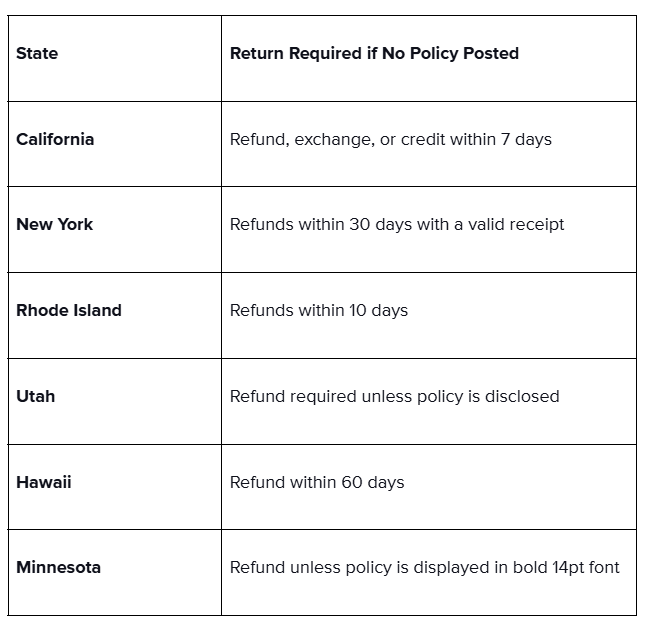
- Buyers can always return defective or misrepresented products
Whether or not a return policy exists, sellers must accept returns for items that are faulty, damaged, or not as described. This is covered under federal and state consumer protection laws.
- You can set your own return window, but it must be visible
Most sellers allow returns within 14 to 30 days. You’re free to set shorter or longer windows, add restocking fees, or require original packaging, as long as it’s clear before purchase.
- Some items are typically non-returnable
Even generous return policies can exclude:
- Opened hygiene items (e.g., underwear, skincare)
- Perishables (e.g., food, flowers)
- Customized or made-to-order products
- Digital products (in some states)
These exclusions should still be stated in your return policy to avoid disputes.
- Make your policy easy to find
Don’t bury your return terms. Best practice is to place your return policy:
- In your website footer
- On product pages
- At checkout
- In order confirmation emails
Set a return policy that fits your business and make sure it’s easy to find, clearly written, and consistent with what actually happens in your return process. For buyers, always check the policy before purchasing. For sellers, assume that no policy means default rules apply.
Once a return is accepted, the focus shifts to how and when refunds are processed. Here’s how that typically works.
Also Read: Online Refund Rights and Return Policies for Goods Bought
How Refunds Work (Timing, Methods, and What’s Actually Refunded)
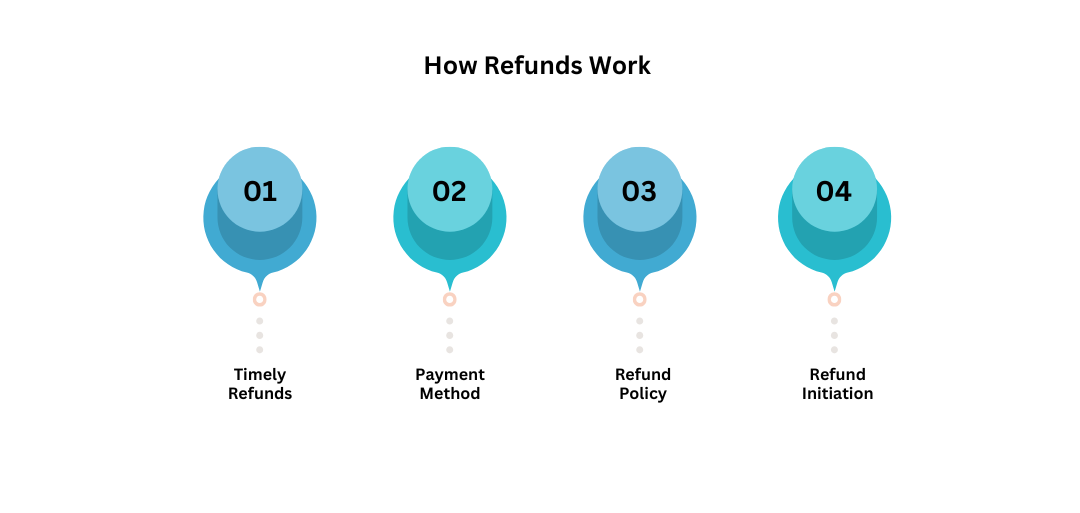
Once a return is approved, the refund process depends on what the seller promised and what the law requires. While there’s no single federal rule that dictates refund timelines for all e-commerce orders, there are best practices and legal expectations sellers must follow.
1. Refund timelines vary, but speed matters
Many sellers aim to issue refunds within 7 to 14 business days after receiving the returned item. In some states (e.g., Utah), refunds must be processed within 30 days of a valid request. If a seller causes unreasonable delays or ignores refund requests, that can be treated as a breach of contract.
2. Original payment method is standard
Most refunds go back to the original payment method (credit card, PayPal, etc.). Store credit is also common, but only if the buyer agrees to it or the return policy clearly states it in advance.
3. Shipping and restocking fees may or may not be refunded
Basic shipping costs are sometimes refunded, especially if the product was faulty or misrepresented. Expedited or premium shipping charges are usually non-refundable, unless the seller explicitly includes them. Restocking fees (often 10–20%) are allowed, but they must be disclosed clearly before purchase.
4. Return confirmation triggers the refund
Many sellers wait until the returned item is received and inspected before processing a refund. It’s important that tracking is available and communication is clear so the buyer isn’t left guessing.
Return Policies for Different Retailers
Here’s how some major U.S. retailers handle returns:
- Amazon: Generally offers a 30-day return window. Some categories, like electronics, may have stricter rules. Prepaid return labels are commonly provided.
- Walmart: Allows most returns within 90 days. Exceptions apply to electronics and large appliances.
- Best Buy: Offers a 15-day return window for standard purchases. Members and Best Buy credit card holders may get up to 30 days.
- Target: Most items can be returned within 30 days. Electronics and entertainment items usually must be returned within 15 days.
Refund management can quickly become a burden for businesses, especially at scale. Tools like Return Prime centralize and automate the entire refund and exchange workflow. This means faster refund approvals, accurate status tracking, and clear refund options for the customer (including store credit or smart exchange suggestions to reduce refund volume).
After understanding how the return process works in e-commerce, let’s now understand who bears the shipping costs for returns.
Who Pays for Return Shipping?
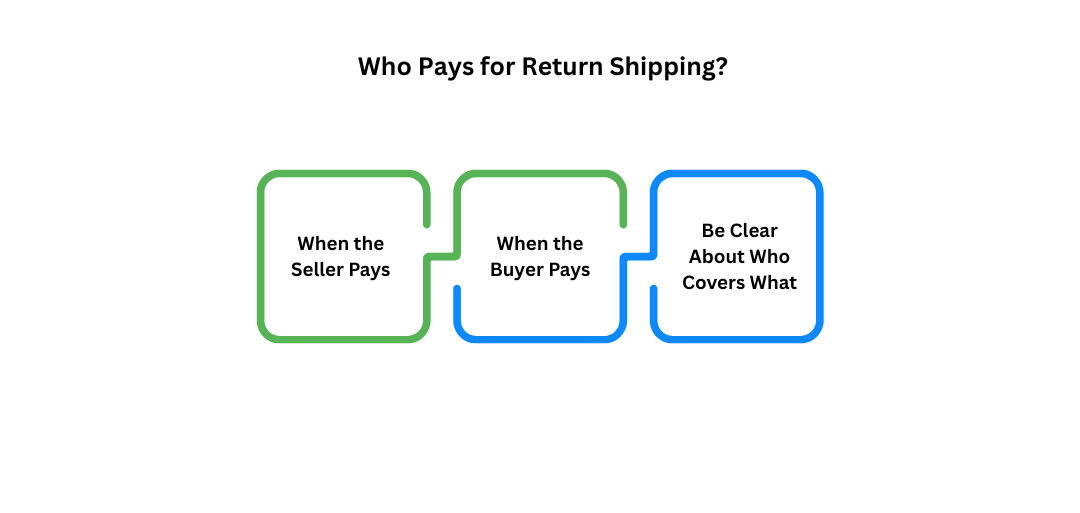
Return shipping costs are one of the biggest sources of confusion and frustration for buyers and sellers. U.S. law doesn’t mandate who must pay for return shipping, but there are clear expectations depending on the situation and the seller’s policy.
1. When the Seller Pays
If the item is defective, damaged, or not as described, most sellers are expected to cover return shipping. Some platforms (like Amazon) automatically offer prepaid labels in these cases. If your return policy says you’ll handle these issues, you’re legally bound to follow through.
2. When the Buyer Pays
If the return is due to buyer preference (wrong size, color change, changed mind), return shipping is usually the buyer’s responsibility, unless the seller offers “free returns” as part of their policy. Some sellers deduct shipping fees from the final refund amount if prepaid labels are used.
3. Be Clear About Who Covers What
Return shipping terms should be clearly posted in the return policy, not buried in fine print. If you’re going to deduct shipping costs or charge for return labels, it must be disclosed before the sale.
Manually managing return labels isn’t scalable, especially if you're shipping across regions or using multiple carriers. Sellers using Return Prime can automatically generate and manage return labels by integrating with shipping providers like Shippo, ShipStation, USPS, FedEx, and Easyship. This reduces back-and-forth with customers and ensures returns are tracked properly.
Now that we clearly understand who pays for shipping costs let’s now understand the laws for handling the return related to faulty and damaged products.
Handling Faulty or Damaged Items
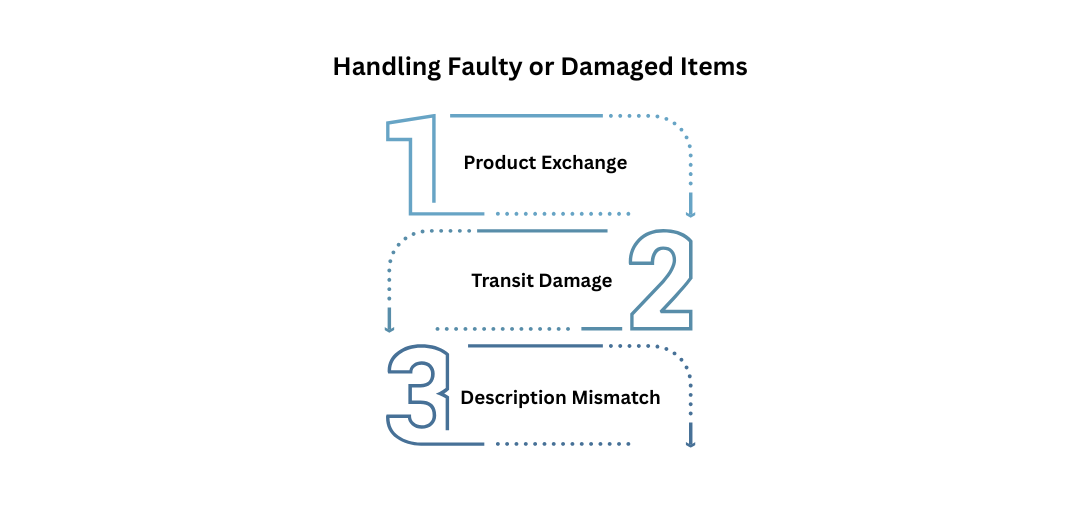
Returns aren’t always a change of mind. Sometimes, things arrive broken, defective, or completely different from what was advertised. Federal and state laws offer buyers strong protections in those cases, and sellers have little room to say “no.”
Here’s what the law says about handling faulty and damaged items.
1. Defective or misrepresented items must be refunded or replaced
Under the implied warranty of merchantability, products sold by merchants in the U.S. must be fit for their ordinary purpose and meet basic standards for quality and performance. If a product is defective or does not work as expected for its intended use, the buyer may be entitled to a refund, repair, or replacement, even if there is no written warranty, unless the seller has specifically disclaimed or limited the implied warranty.
2. Damaged-in-transit goods count, too
If an item shows up damaged, the seller is responsible, even if the damage happened during shipping. Unless the shipping terms explicitly shift risk to the buyer (rare in D2C ecommerce), the seller must handle the return.
3. If the product doesn’t match the description, it’s legally defective
Photos, specs, and product descriptions matter. If the actual item differs in size, material, color, or functionality, buyers can demand a refund—even if the product “works.”
What Buyers Should Do
Report issues quickly, ideally within the return window. Provide clear proof (e.g., photos, order number, description of the problem). Ask for a refund, replacement, or store credit (depending on what the seller offers). If the seller refuses to resolve the issue and the item was paid for with a credit card, the buyer can file a chargeback, usually within 60 days of the statement date.
What Sellers Should Be Ready For
Sellers should keep these points in mind
- These returns are not optional; refusing to accept them could violate consumer protection laws.
- Set up a clear internal process for verifying product issues and issuing resolutions fast.
- Don’t force buyers to pay return shipping if the problem was your fault (or your supplier’s).
If you’re buying from or selling to customers outside the U.S., things get more complex. Let’s understand how international returns work in e-commerce.
International Orders: What Changes (and What Doesn’t)
Buying or selling across borders adds complexity to returns. In most cases, U.S. consumer protection laws do not fully apply or are difficult to enforce when the seller is located outside the country, making it harder for U.S. buyers to obtain refunds or returns from foreign sellers.
Here is what buyers and sellers need to know about international orders.
For U.S. Buyers Ordering from Overseas
- U.S. laws usually don’t cover overseas sellers unless they have a physical U.S. presence or target U.S. consumers. That means neither the FTC rules nor most state return laws apply.
- You’re considered the importer, so you’re responsible for customs rules and must ensure the product complies with U.S. regulations (e.g., FDA, CPSC).
- Return shipping is almost always your responsibility if the product isn’t defective or misdescribed.
- Using a credit card for added protection many international disputes fall back on the card issuer’s chargeback process if the seller won’t cooperate.
For Sellers Shipping Internationally
- Make your policy crystal clear
Whether you accept international returns or not, state that policy directly on the product page or checkout screen. List the countries you ship to, what’s returnable, and who pays for the return.
- Include estimated refund timelines
Cross-border returns can take longer due to customs, carrier delays, and currency differences. Be upfront about how long refunds take and under what conditions they’re processed.
- Account for higher costs
International return logistics can be expensive. Many sellers charge for return shipping or offer store credit instead of cash refunds to help offset the cost.
International returns require clear, upfront communication and careful logistics. Your return policies should be explicit and visible, and you should follow best practices to simplify the process for global customers. Using a tool like Return Prime helps in centralizing the entire process. Here’s how.
How Return Prime Helps Shopify Sellers Operate Smarter
Handling returns is complex. Manual workflows cost time, money, and customer trust as return volumes grow. That’s where platforms like Return Prime come in.
Return Prime integrates with over 30 apps, including Shippo, ShipStation, USPS, FedEx, and Easyship, ensuring smooth coordination across fulfillment networks. This helps merchants automate return processes with minimal manual work.
For example, Bummer, a D2C brand, used Return Prime to optimize its return process. The result? A 74% drop in return requests and an 87.5% faster return processing rate. With automation and real-time tracking, Bummer improved customer satisfaction and operational efficiency, reinforcing Return Prime’s ability to transform returns into a competitive advantage.
Here's how Return Prime, rated 4.9 stars by Shopify users and trusted by 10,000+ brands, can enhance your returns process:
- Centralized Return Management: You can handle returns, exchanges, and refunds in one place, making it easy for customers and your team to manage every request.
- Wonder Revenue Booster: You suggest new or related items during returns, turning a possible loss into a chance to improve your sales and keep money coming in.
- Encourage Exchanges: You guide customers toward swapping items instead of getting refunds, keeping your sales while ensuring their satisfaction.
- Wonder Promotions: You turn refunds into store credits, motivate customers to shop with you again, and keep their business tied to your brand.
- Wonder Bot Automation: By letting automation handle notifications, approvals, and return steps, you can save time and avoid slip-ups, keeping everything smooth and reliable.
- Design return and exchange policies: You shape a return process that fits your brand’s look and feel, adjusting it to suit your customers while staying in charge of its operation.
- Insightful Analytics: You monitor return patterns and use an ROI calculator to assess their impact, which helps you tweak plans and reduce losses.
- Seamless Integrations: You tie in with top software and shipping services, making the return process easier and more hands-off from beginning to end.
Conclusion
Understanding how buying through ecommerce site returns law works in the U.S. helps both buyers and sellers avoid confusion. Buyers don’t always have the right to return something just because they changed their mind, but they do have protections if the item is defective, misrepresented, or delivered late. Some state laws also require sellers to accept returns if they don’t post a clear policy.
For sellers, once a return policy is posted, it becomes legally binding. Managing returns well can build trust and reduce losses. Using a tool like Return Prime makes return handling faster and more organized, helping sellers turn refund requests into exchange opportunities or store credit.
Want to simplify your returns process? Return Prime automates the entire workflow, from generating labels to tracking returns. It keeps everything organized behind the scenes so you can focus on what matters. Get in touch to learn how it works.



.jpg)



.svg)


.svg)